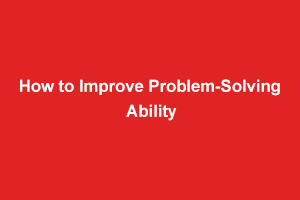Identification:
The first step to solving any problem is to identify the problem(s) you might want to solve. This means that to identify a problem, you must know where it is meant to be and there should be a clear understanding of where the problem is raised. In other words, you can have a clear understanding of what it is that you’re hoping to solve. If you’re working with a team, it’s all the more important that you have to share an understanding of the single problem you’re facing.
Analysis:
A problem analysis is an investigation or searching for that causes an issue or a problem. As part of this stage, you may look deeper and try to find the root cause of a specific problem at a team or organizational level.
Finding a solution is to go through at data that you have collected about the problem and to analyze its importance. When you analyze, you will further look for links and relationships in every situation that will help you for a better understanding. Sometimes, the information will need to be broken into smaller, more manageable parts or to be ranked for its importance or relevance.
Generating Solution:
Once a team has nailed down the particulars of the problem you wish to solve, you want to encourage a free flow of ideas connecting to solve that problem. So it’s time to start thinking about possible solutions and the most accurate solutions. This step requires creativity and brainstorming as you think of a few ideal solutions. Solving problems usually involves creating some plans in order to contain further problems. After going through all the scenarios, organize solutions into groups around common themes.
Decision Making:
Once you have a list of possible solutions, methodically narrow down your list to the best solution. If you’re working as a team, then you have to make decisions together, so try to make decisions with its pros and cons and arrive at a consensus solution.
In other words, you can figure out who will do what, how the success of the solution will be measured, and decide the next course of action.
Implement the solution:
Now the problem-solving strategies have the end, the goal of implementing a solution and solving a problem.
Remember that for any solution to be successful, you need to help your team through all of the previous problem-solving steps thoughtfully. Only then you can ensure that you are solving the right problem but also that you have developed the correct solution and then can successfully implement it.
Solution evaluation:
So you and your team developed a great solution to a problem and have a gut feeling it’s been solved. Work is done, right? All problem-solving strategies benefit from evaluation, understanding, consideration, and feedback. You might find that the solution does work for everyone, might create new problems, or is potentially so successful that you will want to roll it out to larger teams or as part of other initiatives.
None of that is possible without evaluating the success of the solution you developed in your problem-solving model and adjust if necessary.
Remember that the problem-solving process is often iterative and it can be common to not solve complex issues on the first try. Even when this is the case, you and your team will have good knowledge and confidence that will be important for future problem-solving workshops or in other parts of the organization. If a solution didn’t work, you need to have the data and records to see why that was the case. If you write all the scenarios that help to solve your issue rapidly and help to save time. Data and insight are invaluable at every stage of the problem-solving process and this one is no different.
StudySection gives an opportunity to beginners and experts in .NET framework to go through StudySection’s .NET Certification Exam and get a .NET certification for enhancement of career in programming. If you have knowledge of the .NET framework then you can get a certificate through an online exam at StudySection.




